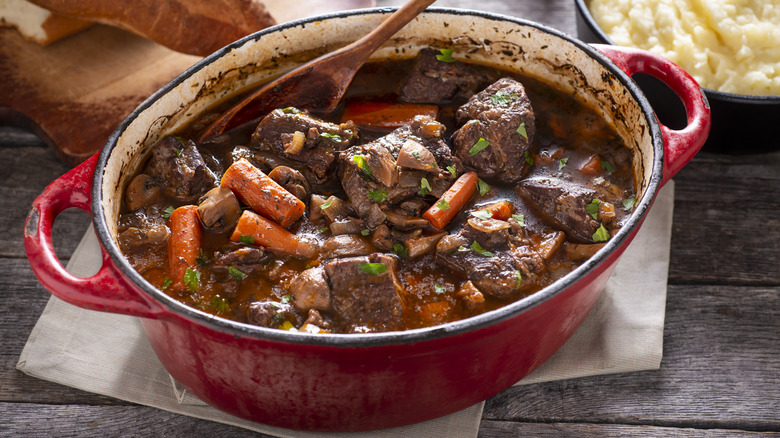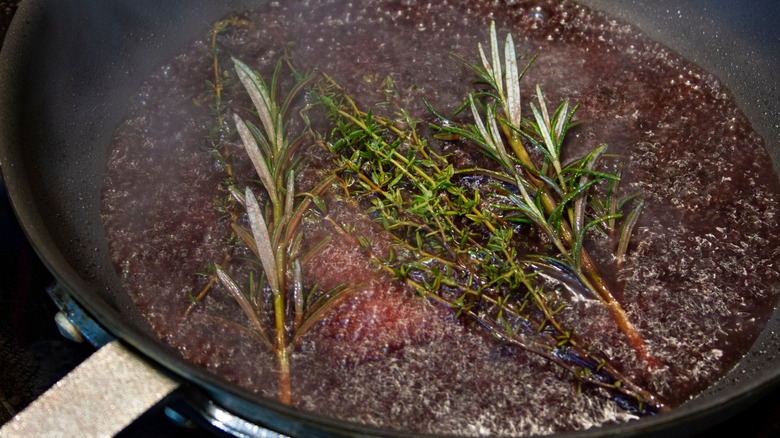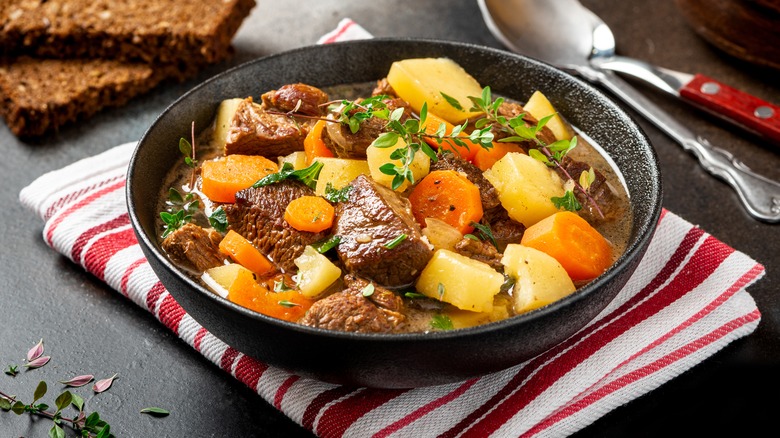The One Crucial Step That Will Make Or Break Your Homemade Stew
In the calendar year of the dedicated cook, stewing season comes after grilling season. Stewing season brings many culinary delights: Seared meats in velvety sauces, the pervasive, cozy atmosphere created by the smell of a long braise, and root vegetables in all their glorious iterations. When embarking on your stewing season odyssey, remember the one crucial, universal step to maximizing any stew's depth of flavor: Deglaze that sucker. Those bits stuck at the bottom of your stew pot? They're little caramelized gifts from the cooking gods, and reincorporating them will level up your hearty stew game.
For the uninitiated, deglazing doesn't involve setting anything on fire — nor does it involve using alcohol, if you're not so inclined. Rather, it's a simple, vital step between finishing the sautéing process and initiating the braise that can be accomplished even with plain old water — any liquid will deglaze a pan. Before we get into the hows of deglazing, perhaps we should discuss the whys.
Deglazing makes the stew more flavorful
In general, the process of making a stew — and particularly searing cubes of meat — creates the aforementioned little caramelized gifts. Bits of cubed chicken breast or stew beef will stick to the bottom of your stew pot during high-heat cooking processes. Soon, they become concentrated little flavoring agents known as fond. Deglazing will loosen up the fond, prevent it from burning, and make the stew taste that much better.
The same principle is applied to making pan sauces. Fond will enrich and help thicken whatever liquid is used for deglazing, as well as the subsequent pan sauce or stew gravy. The reason fond is so desirable is that it's undergone a more intensive cooking process than whatever it used to belong to — in other words, while the cube of beef sautéed over high heat will get nicely browned, the little pieces of fond that used to belong to it but are now stuck on the pan will become caramelized. That means they're darker, sweeter, and more deeply flavored.
Deglazing 101
If you have a passing familiarity with deglazing, you're probably conjuring images of it being accomplished with a few healthy glugs of wine straight out of the bottle. And yes, this method works wonderfully well — as does beer, vinegar, or even apple cider. But guess what? Stock is also a perfectly suitable deglazing agent — as is water if there are no other options. It's up to you.
Deglazing is super simple. Let's say you're making an easy beef stew and have removed the last of the browned pieces of chuck (wisely not overcrowding the stew pot during the browning process to avoid dry meat), leaving behind a pot coated with hot cooking fat and fond. Whack the heat up to high, grab a long-handled cooking spoon (preferably one made of wood), add a relatively small amount of deglazing liquid, and bring it to a boil. Once it's bubbling vigorously, use the spoon to scrape up the fond, noticing how the liquid transforms into something thicker and more aromatic. When the bottom of the pot is clear, feel free to continue making the stew. If you did use wine or beer to deglaze, you now have the added benefit of having cooked off most of the alcohol.


